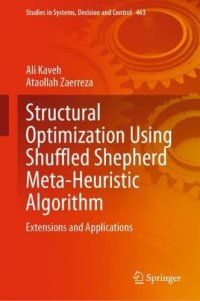
Ebook: Structural Optimization Using Shuffled Shepherd Meta-Heuristic Algorithm: Extensions and Applications
Author: Ali Kaveh Ataollah Zaerreza
- Genre: Computers // Algorithms and Data Structures
- Series: Studies in Systems Decision and Control 463
- Year: 2023
- Publisher: Springer
- City: Cham
- Language: English
- pdf
This book presents the so-called Shuffled Shepherd Optimization Algorithm (SSOA), a recently developed meta-heuristic algorithm by authors. There is always limitations on the resources to be used in the construction. Some of the resources used in the buildings are also detrimental to the environment. For example, the cement utilized in making concrete emits carbon dioxide, which contributes to the global warming. Hence, the engineers should employ resources efficiently and avoid the waste. In the traditional optimal design methods, the number of trials and errors used by the designer is limited, so there is no guarantee that the optimal design can be found for structures. Hence, the deigning method should be changed, and the computational algorithms should be employed in the optimum design problems.
The gradient-based method and meta-heuristic algorithms are the two different types of methods used to find the optimal solution. The gradient-based methods require gradient information. Also, these can easily be trapped in the local optima in the nonlinear and complex problems. Therefore, to overcome these issues, meta-heuristic algorithms are developed. These algorithms are simple and can get out of the local optimum by easy means. However, a single meta-heuristic algorithm cannot find the optimum results in all types of optimization problems. Thus, civil engineers develop different meta-heuristic algorithms for their optimization problems.
Different applications of the SSOA are provided. The simplified and enhanced versions of the SSOA are also developed and efficiently applied to various optimization problems in structures. Another special feature of this book consists of the use of graph theoretical force method as analysis tool, in place of traditional displacement approach. This has reduced the computational time to a great extent, especially for those structures having smaller DSI compared to the DKI. New framework is also developed for reliability-based design of frame structures. The algorithms are clearly stated such that they can simply be implemented and utilized in practice and research.